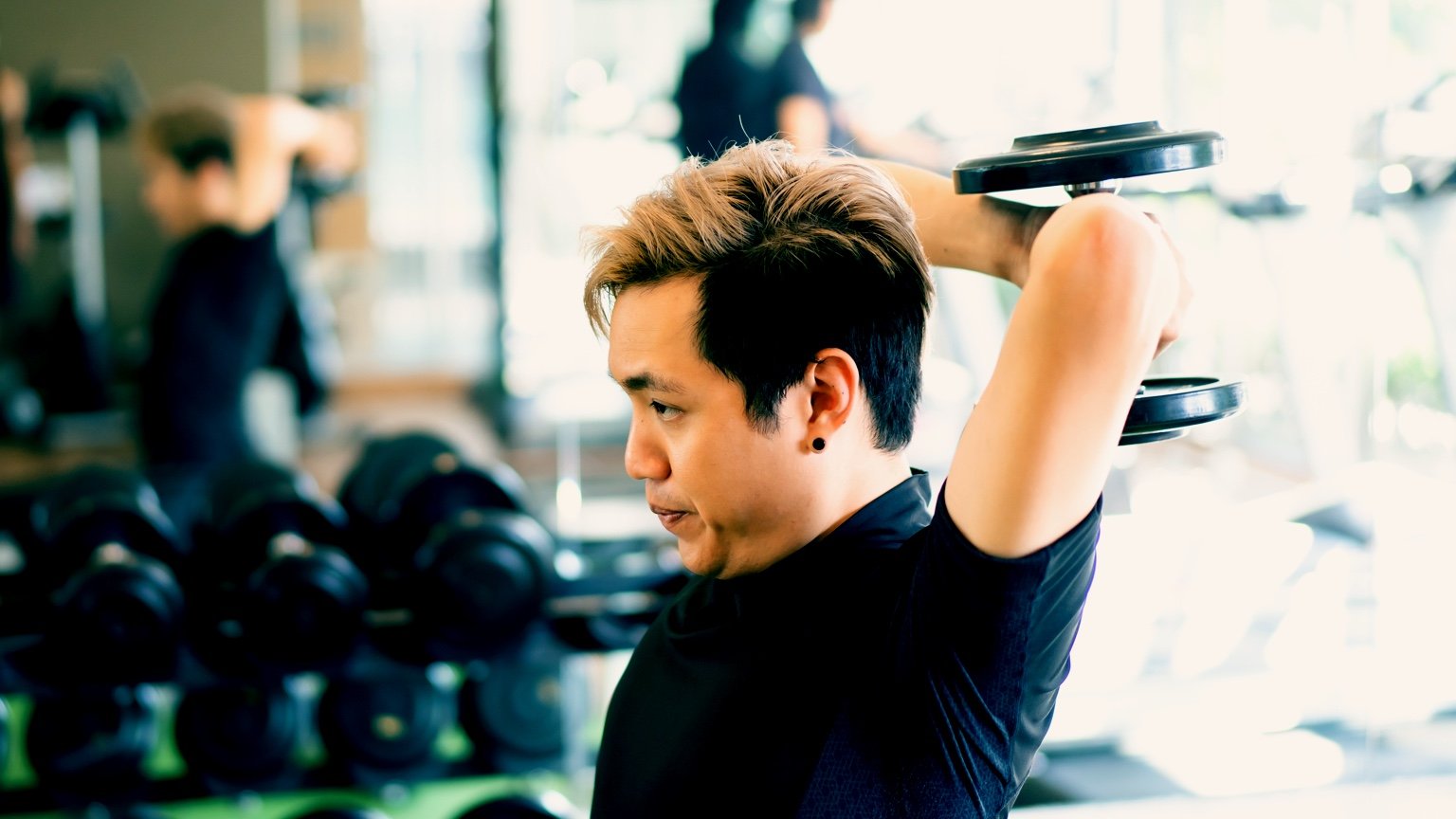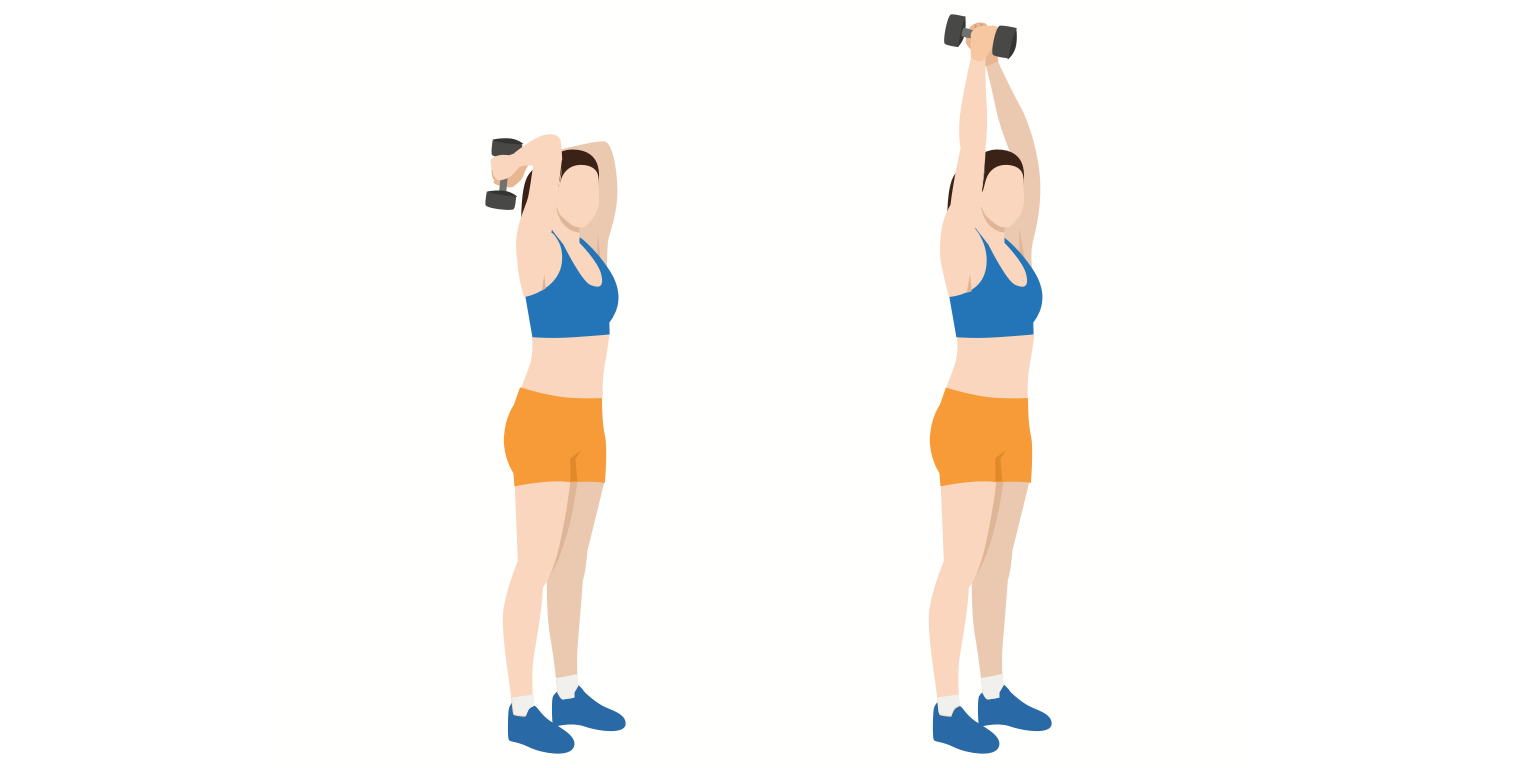Perfect Your Tricep Extension with These Variations

The tricep extension is a type of isolation exercise that targets your tricep muscles. Great for beginners, tricep extensions need minimal equipment, and can improve your upper body strength and give your arms a defined and more toned appearance.
You can perform tricep extensions with dumbbells, barbells, resistance bands or the cable machine.
Tricep extensions are a fundamental type of exercise for your triceps. Normally, your triceps are only worked in conjunction with other muscle groups rather than in isolation. Isolation exercises involve the primary movement of just one joint – in this case the elbow joint – and it is the tricep muscles that are the primary muscles engaged in the movement.
Almost all tricep isolation exercises are variations of the tricep extension. The main goal is to isolate and engage the triceps so you can improve strength and definition in these muscles. The isolation provides you more control over growth and physique, and improves on muscular imbalances.
The tricep extension is a push exercise. Other push exercises include overhead press, bench press and chest flys.
There are various ways you can incorporate tricep extensions into your regular workout routine. It is often included in an upper-body strength training routine, but you can also add it to a full-body workout or to push or tricep-specific workouts.
Benefits of the tricep extension
The main benefit of the tricep extension is the enhancement in size and power of your triceps. Exercises like tricep pushdowns, skull crushers and overhead tricep extensions all engage your triceps, and encourage muscle strength and size.
As well as contributing to a balanced and aesthetically-pleasing upper arm, working the triceps boosts overall arm strength and improves the ability to perform other upper body exercises and everyday activities.
Tricep extensions can also improve shoulder stability and mobility, and reduce tension and tightness in your shoulders. This is because the exercise works muscles surrounding the shoulder joint. Ultimately this can reduce the risk of injury from other workouts and improve your overall shoulder function.
The benefits of this exercise also extend to other compound pressing movements. The triceps are a key secondary muscle in many other exercises, working with the chest and shoulder muscles to extend your arm or push weight. Stronger triceps can therefore improve your overall pressing ability.
Tricep extension variations
There are several variations of the tricep extension, each with their own advantages and disadvantages.
You can perform tricep extensions using one or both arms. The one-arm variations use a dumbbell, which is useful for isolating each side of your body. This can be useful if you have a muscular imbalance. The two-arm variations may also use a barbell or EZ bar. This allows you to pull more weight, which can accelerate growth in muscle strength and size.
You can perform tricep extensions lying down, standing up or on an incline bench. These different positions allow for variation in the resistance and intensity of the exercise, which can make the workout more challenging and effective.
We recommend exploring different extensions to add variety to your workouts and to target different parts of your triceps muscle. This approach will target your triceps from different angles providing comprehensive muscle conditioning. Using multiple variations also avoids plateaus in your training.
Popular tricep extension exercises
The straight bar tricep extension allows you to pull more weight, especially on the cable machine. With a firmer grip, this variation also provides a consistent range of motion and constant tension throughout the movement. This can increase your muscle strength and endurance, and also makes it easier to maintain the proper form and control.

Dumbbells are another popular choice for tricep extensions. They have some key advantages versus the cable machine. Working with dumbbells requires a greater level of coordination and stability and control over the range of motion. This means your stabilizer muscles will be engaged throughout the exercise, which enhances your overall strength and balance. So if you want to improve your coordination and stability, dumbbells is the way to go.
A 2019 study showed that free weight training benefited tricep strength compared with machine exercisers. A later 2020 study, however, showed no significant effect in muscle mass or strength between free weight training and machine training, though the study did demonstrate an increase in free testosterone levels in men – this was an expected result since free weight training activates more muscle mass.
Dumbbells are also more accessible and suitable for everyone from beginners to frequent gym-goers. Providing a variety of weights, they allow you to progressively increase the resistance in your workout.
Finally, the standing overhead tricep extension is popular triceps exercise. This variation specifically targets the long head of your triceps, which is key for developing upper body strength and toning your arms.
Overhead tricep extension
The overhead tricep extension is the most versatile and adaptable type of tricep extension.
You can perform this exercise sitting or standing up. The standing position engages your core more than if you were sitting, which can help promote improvement in balance and stability. This can help you improve your posture and strengthen your core muscles.
If you choose to sit, you can use a stability ball, bench or chair.
How to perform overhead tricep extensions

- Stand with your feet shoulder-width apart, with your weight evenly distributed. Keep your knees slightly bent.
- Engage your core for stability, and draw back your shoulders.
- Hold a lightweight dumbbell with both hands, and bring it back behind your head. Your elbows should be bent at a 90-degree angle with your upper arms pointing upwards. Keep your elbows close to your head and ears.
- To move, extend your arms up towards the ceiling, lifting the dumbbell above your head. Exhale during this movement, remembering to keep your upper arms stationary – only rotate your arms about the elbows.
- Once your arms are fully extended, pause, then slowly return to the starting position. Inhale as you lower the dumbbell.
- Repeat for the desired number of repetitions.
Sets and reps
A good place to start is 3-4 sets of 10-15 reps. It is important to maintain proper form throughout all sets and reps.
Take rest periods of 60-90 seconds between sets. Rest helps your muscles to recover and prevents fatigue, which ultimately enhances performance.
You can do sets to failure, but it’s important to maintain proper form. It is safe to hit muscle failure if done correctly.
Common mistakes
A common mistake in overhead tricep extensions is allowing your elbows to flare out to the sides. This shifts the focus away from your triceps and onto other muscles, such as your biceps. This is not only less effective, but can increase your risk of injury.
Check yourself in the mirror when performing this exercise. If you struggle to maintain the proper form, reduce the weight you are lifting.
Straight bar tricep extension
Cable machine tricep extensions are a great way to work your tricep muscles! The cable machine makes it simple to target different tricep regions, simply by changing the attachment. Common attachments include rope, the straight bar and the V-bar. Each offers a unique challenge.
Remember to keep your elbows close to your body, to allow the full extension and maintain proper form.
The straight bar tricep extension uses the straight bar attachment. This provides a stable and controlled movement, and is good for beginners.
How to do straight bar tricep extensions

- Set up the cable machine by attaching the straight bar to the high pulley. Adjust the weight according to your strength level and goals.
- Stand directly in front of the cable machine, with your feet shoulder-width apart for balance.
- Grip the bar with an overhand grip (palms facing down). Your hands should be closer than shoulder-width on the bar.
- Take a half-step back from the cable machine. Bend ever-so slightly at your hips. Engage your core and put the focus on your triceps.
- Extend your elbows to push the bar down. Focus on flexing your triceps, and continue until your arms are fully extended, but without straining your elbows.
- Squeeze your triceps, and return to the starting position in a controlled movement.
Lying dumbbell tricep extension (Skull Crushers)
The lying dumbbell tricep extension, often known as Skull Crushers, is an effective exercise for toning your arm muscles. This variation sees you lie flat on a weight bench with one or two dumbbells. It is a useful exercise for targeting your tricep muscles and can enhance overall arm strength.
How to do lying dumbbell tricep extensions

- Position yourself on a weight bench, lying down, with your feet firmly on the ground. Make sure your back is fully supported.
- Holding a dumbbell with both hands, bend your elbows and lower the dumbbell behind your head. Your palms should be facing upwards.
- Keeping your upper arms stationary and pointing towards the ceiling, straighten your elbows and raise the weight back up using your triceps. Move until your arms are fully extended.
- Next, lower the weight back behind your head in a slow and controlled motion.
- Repeat for the desired number of reps
Triceps muscle
Your triceps muscle is made up of three heads – the long head, lateral head and medial head. Each of these heads originate from a different location but converge to form a single muscle. The triceps support a broad range of movements and are crucial for arm strength and functionality.
The three heads all work to allow forearm extension at the elbow. When your tricep contracts, it straightens your arm.
The long head of your tricep originates from the infraglenoid tubercle of your scapula. This head helps with extension at the elbow and also adduction and extension at the shoulder joint. It runs down the back of your arm and inserts into the olecranon process of the ulna.
The overhead extension effectively targets the long head of your triceps. This exercise works the long head, allowing it to strengthen and grow in size. A well-developed long head contributes significantly to larger and fuller triceps. This is the muscle mass you will see on the backside of your arm.
The lateral head originates from the humerus. It is positioned on the outside side of your upper arm and gives your tricep its unique ‘horseshoe’ shape and width. It inserts into the olecranon process of the ulna. The lateral head allows rapid and forceful arm extensions, and is key in any pushing or punching movement.
Pushing exercises like push-ups and bench press are effective in strengthening the lateral head.
Finally, the medial head originates from the humerus and inserts into the olecranon process of the ulna, and plays a key role in precise movements and stability.
References
Schott, N., Johnen, B., & Holfelder, B. (2019). Effects of free weights and machine training on muscular strength in high-functioning older adults. Experimental gerontology, 122, 15-24.
Schwanbeck, S. R., Cornish, S. M., Barss, T., & Chilibeck, P. D. (2020). Effects of training with free weights versus machines on muscle mass, strength, free testosterone, and free cortisol levels. The Journal of Strength & Conditioning Research, 34(7), 1851-1859.
